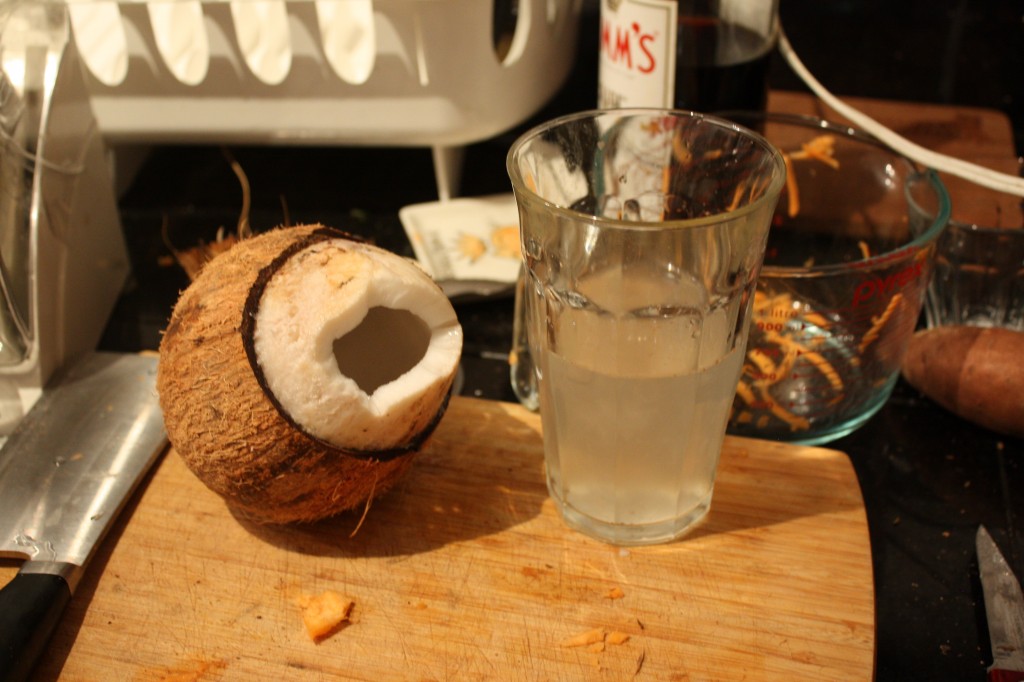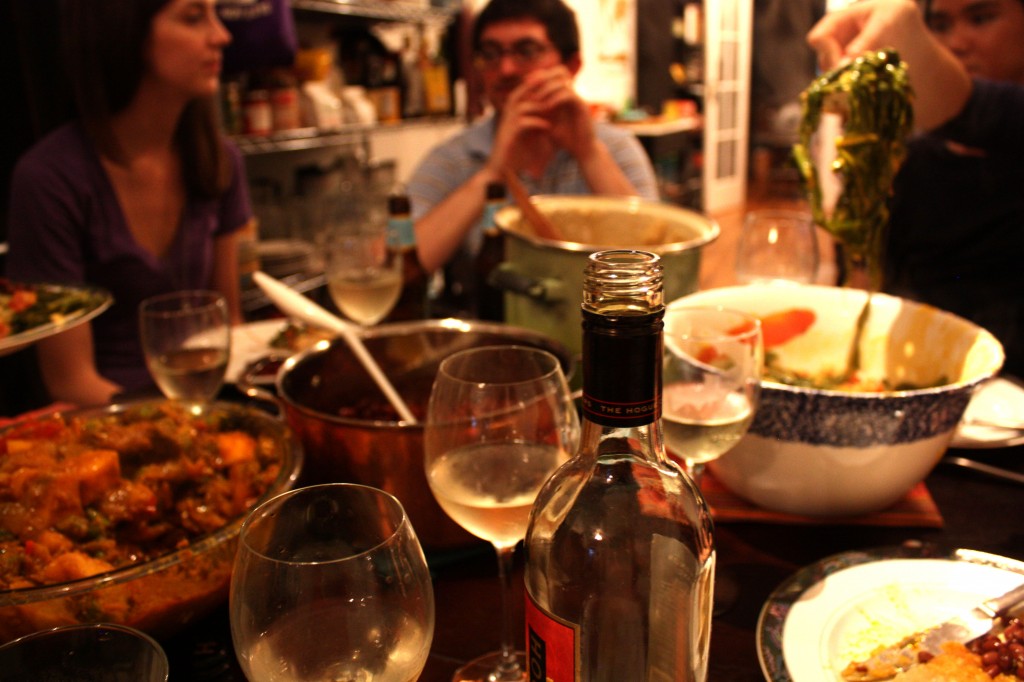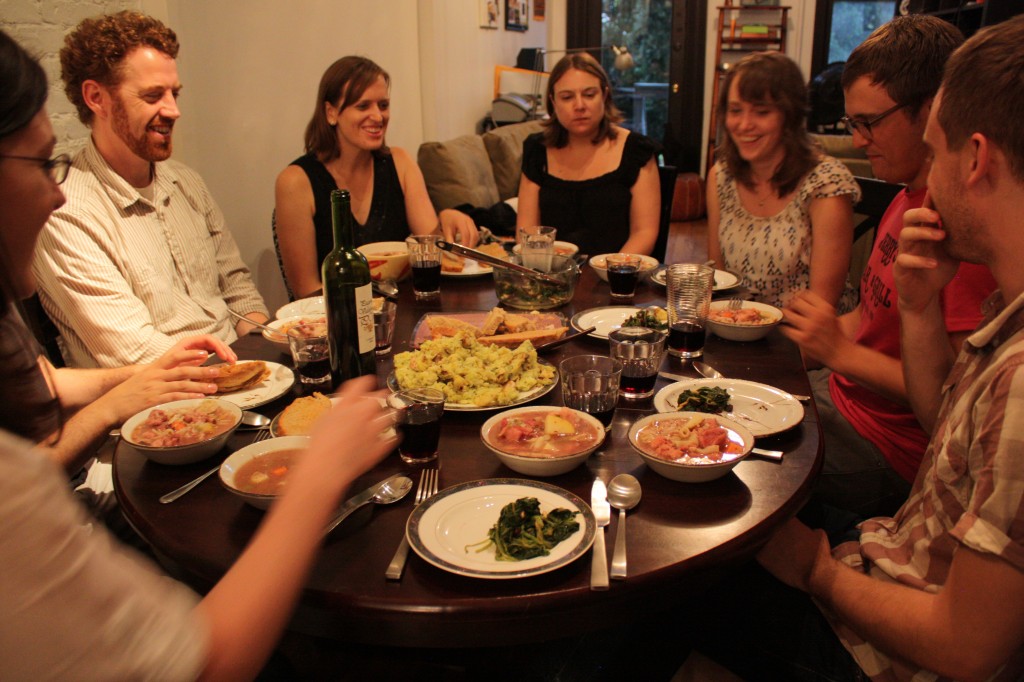It's been said that there's no cuisine in Argentina, only beef. So this week, I did my best to throw together an Argentinean asado, the classic communal barbecue whose tradition began from the gaucho days out on the vast grassy pampas. Accordingly, I felt it imperative to find grass-fed beef, so I schlepped up to the Meat Hook in Williamsburg for the biggest single meat purchase of my life. Thankfully, the rain threatened in the forecast never materialized, so not only was the outdoor cooking not a problem, but we could all hang out on the porch.
Tonight's guests were: Liz (visiting from California), Vicky, Caroline, Ben, Nick, Bex, another Ben, and Gina. The meal is listed in the order served, but I actually had to prepare it in reverse: the dessert took five hours start to finish whereas the sausages cooked in mere minutes.
The grill
My research made it clear that the gas grill just wouldn't work. Apparently the asado is all about indirect, slow cooking, with the smoke and the distinctive glow of wood and/or lump charcoal providing the sear and the flavor. Finding the traditional quebracho (from "quebra hacha" or axe-breaker) wood seemed like a fool's errand on short notice, so I did the next best thing and got both firewood and lump charcoal (which is to say, real pieces of tree and not briquets). I built up a fire in a somewhat dilapidated old barbecue that the previous tenants left behind, and waited quite a while for it to build up and die down. Once it was manageable, I piled the wood and charcoal to one side, making a hotter and a cooler side — see how the fire is on the right here.
Chimichurri | Parsley-garlic sauce | Recipe
You could call it the pesto of Argentina, but this guy would be really angry at you for saying that. A simple yet luscious sauce that I made with parsley from the garden, and didn't make enough of. It got gobbled up. We also made a salsa criolla, which kind of resembles a Mexican salsa but with oil instead of lime. The chimichurri was way more popular.
Chorizo y morcilla | Chorizo and blood sausage
An asado begins with some faster-cooking tasty morsels. such as sausage. (I tried to get sweetbreads too, but neither Meat Hook nor the local butcher had them on hand.) I was pleasantly surprised by how many people enjoyed the blood sausage, especially spread on baguette. Cooked these on the hotter part of the grill, since a) they can take it and b) the rest was occupied by the below. I swear they tasted better than they look here.
Asado de tira | Cross-cut ribs
Grass-fed beef has a beautiful richness of flavor and needs no marinade or spice. Everything I read made it clear that to use anything but salt would be inauthentic. So these ribs, these beautiful, cross-cut, fatty, 1.5-by-24-inch strips, got nothing but some half-coarse salt before hitting the grill. They were so fatty I could barely see the meat when throwing them on, but in time the fat melted and revealed the luscious morsels of rib meat. The outside was salty and crunchy, the inside not rare but not overdone. Topped with a little chimichurri, these were just heavenly.
Secreto de cerdo | Pork skirt steak
I was looking for matambre de cerdo, (matambre = "mata hambre" or hunger-killer) translated as pork flank steak, but this is the closest I got. Couldn't have been much better! According to this account, it's called "secreto" because the butcher used to cut this piece for himself and not share with customers. What a great bit of meat for grilling: thin, fast-cooking, and wonderful with salt and just a squeeze of lemon while cooking. This lasted all of two minutes on the butcher block.
Ensalada | Salad
Between the pork and the main event, we had a simple salad of farmer's market lettuce and cucumber. Gotta have something green to cut the grease, right?
Tapa de nalga | Top round
Ta-da! This 3.5-pound piece of meat took over two hours to cook, spending most of that time off to the side. Wasn't quite done when I took it off the first time, so I threw it on top of what remained of the coals, blowing them to get their last little bits of heat out. A great piece of meat for a party, because different parts are more or less rare so everyone's happy. But no matter your doneness preference, it was rich and flavorful and so purely meaty.
Gelato con dulce de leche | Gelato with sweet caramelized milk syrup | Recipes: gelato; dulce de leche
Caramelization is one of the most wonderful accidents of science. It took like four hours, with skimming skins of milk and a lot of very slow cooking, to make the golden goop for which Argentina is famous. I paired it with Argentinean gelato, which is a little lighter than most frozen desserts: cream to milk is in a two-to-one ratio whereas normal ice cream is the opposite. The ice cream wasn't quite frozen solid and the dulce de leche was too thin, but nobody seemed to care. Rich milky products with sugar are a sure winner. And in this case, the milk was from (wait for it) grass-fed cows from Milk Thistle Farm, so it was extra delicious.
Oh, and on top of all of this there was plenty of excellent Argentinean wine brought by our guests. Rich and spicy malbec and bonarda grapes balanced the primal meat flavors very well. Next stop next week is all the way over to Armenia -- we're heading back to yogurt-land.
Laura and I agree that this was our favorite meal yet for pure flavor excitement. And although we're shocked there's no leftover meat, we do still have a cup of dulce de leche.




